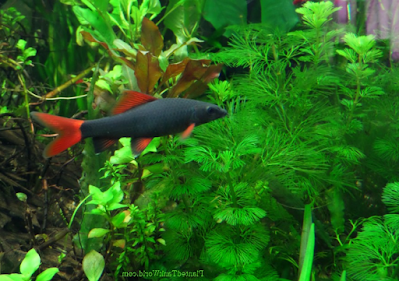
Rainbow Sharks and Their Lifespan, Care Guide, Eggs, Size, Tankmates & Food
Rainbow sharks (Epalzeorhynchos frenatum) are unique and tropical fun fish that are very rewarding to keep in your aquarium. But, you should know a few things before you think about getting this beautiful fish for your fish tank.
Again, the rainbow shark is one of the most misunderstood fish in the fishkeeping world (especially by beginners). So we thought it was very important to set the record straight and lay out the facts.
In this article, we are going to cover its origin, appearance, behavior, how to care for them, Rainbow Shark tank fish mates/compatibility, dietary needs, breeding, and much more…
At the end of reading this article, you are done. You’ll have a complete understanding of them and what they require to thrive in a fish tank.
They are also called Ruby Sharks or Redfin Sharks, which are tiny tropical freshwater fish native to Southeast Asia. Especially, they live in the rivers of Thailand, Myanmar, Malaysia, and Laos. These tropical sharks are famous for their vibrant red fins and for being territorial.
They’re not saltwater fish, but instead, they thrive in freshwater. If you are looking to add some attitude and color to your fish tank, this could simply be these freshwater aquarium sharks for you.
Let’s begin with a quick outline before we move on to discuss their compatibility and appearance with other fish.
Let’s get started
Category | Rating |
Care Level: | Easy/Moderate |
Temperament: | Semi-aggressive |
Color Form: | Gray, Red |
How long do Rainbow Sharks live? | 5-8 Years |
Size: | Up to 6″ |
Diet: | Omnivore |
Family: | Cyprinidae |
Minimum Rainbow Shark Tank Size: | 50 Gallons |
Tank Set-Up: | Tropical Freshwater: Rocks, Plants, or Caves |
Compatibility: | It is Moderate and gets along with so many other freshwater fish species |
Overview
The Rainbow Shark may be a tropical freshwater cyprinid that’s somewhat difficult to keep. It might be suitable for fish keepers who have a couple of years of experience and are looking to expand their aquarium.
They are popular for their territorial nature and bright, vibrant red fins.
Originating from the nice and cozy rivers of Southeast Asia, they got the affectionate common name of Rainbow Shark, because of their upright dorsal fin, which gives them the look of a shark.
You should expect your Rainbow Shark to grow to six inches long and have a lifespan of 5-8 years.
If your intention is to keep these tropical sharks, you must ensure your aquarium has lots of hiding places for them, as this helps to decrease their territorial behavior.
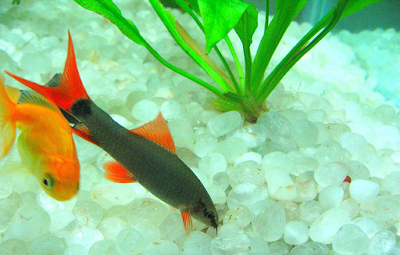
Rainbow Shark Price
In terms of cost, you must be looking to spend no over $3 per fish, and they are readily available all year round.
Rainbow Sharks’ Appearance
They are mostly popular for their red fins, which are basically what gives them their name. Apart from being red, sometimes their fins may take on an orange hue as well.
The Rainbow Shark could be a dark gray fish with vibrant orange/red fins. Some also have a dark blue body, which is somewhat less common. They have an extended, flat stomach with a pointed snout and an upward dorsal fin. It’s this fin that provides them with the look of a shark.
It is a tiny fish that you ought to expect to grow up to around6 inches when fully mature. It is impossible to spot their gender whilst they’re juveniles. You’ve got to wait until they’re sexually mature.
Rainbow Shark Male or Female
There are some color differences between males and females. For instance, males tend to have brighter orange or red fins than females do.
Males also have very thin gray lines on their tail fins, while the females do not have any thin lines.
Female rainbow sharks are also thicker and have more rounded bellies than males. It becomes apparent as the fish mature, as there is primarily no distinction between the juvenile male and female rainbow sharks.
You will have to wait until the red-tailed fish are physically mature to differentiate between males and females.
Once they become sexually mature, females will have thicker bodies, and males will develop small black lines on the tail fin. Whilst males are going to be thinner, they are going to generally have brighter colorations.
The Albino Rainbow Shark or Albino Shark is a common variety of the Rainbow Shark.
Whilst the Albino Red Tail Shark maintains the orange/red fins, its body is white. It will grow to an identical size as a traditional and standard Rainbow Shark and matches a few of their features, including being territorial.
Rainbow Shark Lifespan
The average lifespan of a rainbow shark is between four to six years, however, some of them have been known to live for as long as eight years or more.
That is longer than other aquarium fish like Bettas, which can only live for about two years. But, it is much less than goldfish, which may have a long lifespan of up to twenty years.
The Albino Rainbow Shark
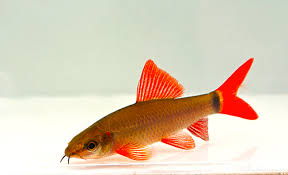
There is an albino version of the rainbow shark, which is popularly known as the Albino Rainbow Shark. This fish has the same red fins as the rainbow shark possesses, however, it has a white body rather than black or blue markings.
The body of an albino rainbow shark can take on a yellow or light pink hue as well. The beautiful and light-colored body, contrasted with the brilliant fins it has, gives the albino shark a very unique, yet highly sought-after appearance.
General Behavior and Temperament
In the natural habitat, rainbow sharks are more passive, and they do not really prey on other aquatic animals or fish. They are territorial fish. It can cause certain behavioral issues like aggression and dominance.
This generally happens as they grow up. As juveniles, these sharks are timid and can spend large periods of their time hiding. They are a kind of Labeo shark.
Are Rainbow Sharks bottom feeders? They are very active swimmers and tend to spend most of their time dwelling at the bottom of the fish tank. Because of them being bottom-dwellers, they are referred to as aquarium cleaners as they can eat the growing algae on the bottom of the fish tank.
Make sure your aquarium has plenty of space and is long enough for your Rainbow Shark to swim at the same water level. Whilst they’re peaceful with fish that dwell in higher water levels, they’re known for fighting with bottom-dwelling fish, including their species.
Some of the behavior can include chasing, biting, and head-and-tail butting.
You can plan to minimize this behavior by ensuring they’re placed in a comparatively large aquarium, with a low fish to water ratio. Also, you have to ensure they have plenty of hiding places, like tunnels, caves, and other hollowed-out décor.
Lastly, whilst they are not known for jumping, it is not unheard of. That is why you should make sure your lid is well fitted to prevent them from jumping out of your fish tank. When they are first placed in the aquarium then jumping generally occurs.
Rainbow Shark Care
There are a couple of things you have to consider when it involves caring for rainbow sharks. Overall, they’re tough little guys and don’t require to be babied, but that’s assuming you’re taking care of their essential needs.
Below, we highlight the most important areas that you simply have to concentrate on when it comes to caring for them. If you stick with these guidelines, you’ll be on your way to ensuring that they live a cheerful and healthy life.
Habitat and Tank Requirements
As mentioned in the overview section of this article, Freshwater Rainbow Sharks are tropical shark fish and they originated from Thailand.
They are very active swimmers, therefore, the adults shouldn’t be kept in aquariums that are smaller than 50 gallons. The aquarium should even have many horizontal spaces. If your aquarium is too short in length, it can encourage them to become more aggressive and territorial.
If you have a plan on keeping so many Rainbow Sharks, then it is advisable to use at least a six-foot-long, 125-gallon fish tank (however, we do not recommend keeping more than one of this type of shark per aquarium; we will discuss more on this later).
Because of their territorial nature, you should have to make sure your aquarium has plenty of hiding places for them. Think rocks, caves, and treated driftwood.
Plants and dense vegetation also work. Plants may be used to keep the Rainbow Sharks distracted, so it can reduce conflict, and also helps prevent algae.
As for substrate, they’re best suited to sand, as this is often what’s found in their native Thai rivers. Be cautious if you plan to use gravel because the sharp edges can cut you. If you intend to use gravel, make sure the quality of the gravel is very fine.
Lastly, you have to ensure your aquarium lid is fitted well, as they can jump!
Water Details
Maintaining the proper pH levels is extremely important if you want to have the most effective environment for your fish. Rainbow sharks do best in water that’s between 6.5 and 7.5 pH levels.
Before putting them in a brand new tank environment, prepare and ready your water and permit it to cycle for at least 14 days so that it has time to stabilize.
Do Rainbow Sharks need a heater? This is a common question that arises in our minds while keeping this shark in a tank of water. The answer is yes. Use an aquarium heater to maintain your aquarium water temperature between 72 and 79 degrees Fahrenheit.
Upon bringing the rainbow shark to your home, place it immediately into your fish tank using a net.
Doing this can help to prevent shock and give them the best possible environment in which they can thrive.
How Big Do Rainbow Sharks get?
The rainbow shark’s max size at full maturity is usually no longer than 6 inches long. There are some that have grown to be as long as 8 inches, but those are an exception.
This size holds true for normal rainbow sharks as well as the same with the albino varieties. Both males and females tend to be about the same size.
Tank Conditions
You must keep it within the following parameters: pH level 6.5-7.5, 75°F to 81°F, and a water hardness of 5 to 11 DH.
Always try to keep the pH level stable with Rainbow Sharks. Sudden changes in the pH level may be harmful and can cause them to become more aggressive than usual.
The Lighting of the aquarium should be kept at a medium level, and the water movement should be moderate.
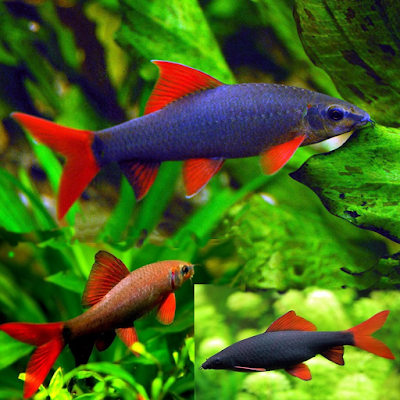
Compatibility and Rainbow Sharks Tank Mates
What can live with a rainbow shark? Are rainbow sharks aggressive?
Let me preface this category by stating that if you’re trying to find a calm community fish, the Rainbow Shark is not the perfect fish for you.
While they are going to get along with a lot of other freshwater fish/freshwater pet sharks, they’re very much territorial, and this will be overwhelming for more shy species, like Marbled Otocinclus catfish and hatchet fish.
As mentioned above in the aquarium and habitat section, they always prefer to take possession of an area of the aquarium; normally, the rocks and small caves.
We have sympathy with any kind of fish that stumbles upon the territory of a Rainbow Shark! They chase the intruders away and can be extremely aggressive. Because of their aggression, you need to be careful while choosing the freshwater sharks for the tank as tank mates.
As a normal rule, they are not aggressive towards species that don’t seem like Rainbow Sharks. As they dwell at the bottom of the aquarium, try to avoid other bottom-dwelling fish species such as catfish and cichlids. Also, you have to avoid any similar-looking fish, i.e., any other semi-aggressive freshwater fish like Purple Glofish, Tetra Glofish, Bala Sharks, and Red Tail Sharks.
While choosing the tank mates for your Rainbow Sharks, always try to find those fish that dwell in the upper and middle levels of the aquarium
You may also want to pick fish that can defend themselves and have a strong but calm personality. Species such as barbs, Gouramis, Rainbowfish, and Danios are all compatible with Rainbow Sharks.
At last, you may use a tiny compatibility trick: the Rainbow Shark should be the final fish placed in the aquarium. This can prevent it from trying to claim the whole aquarium as its own and can reduce territory issues.
Keeping Rainbow Sharks
How many rainbow sharks can live together?
As a simple rule, it is recommended that you just keep one Rainbow Shark in a fish tank at any time. Red Tail Sharks can also be added to this general rule.
They do not tolerate living with their kind as the Royal Gramma does.
In the wild, they simply lead a solitary lifestyle, and they are very territorial. In a normal fish tank, generally, there is not enough room, and the bigger Rainbow Sharks will chase the smaller kind of Rainbow Sharks relentlessly until they kill them.
Will rainbow sharks kill other fish? With their increasing age, this territorial nature develops. Therefore,e if you get a pair of juvenile Rainbow Sharks, they might very well start out getting along, however, their relationship may decline rapidly as the rainbow shark grows fully or becomes mature.
Follow the following guidelines if you insist on keeping more than one Rainbow Shark.
- You have to keep a group of them (5 or more). This way, the dominant Red Fin Shark has several fish to chase.
- Never keep only two Rainbow Sharks.
- If you wish to put more than one Rainbow Shark, make sure that each shark has at least a meter of diversified territory.
Rainbow Shark Diet and Feeding Requirements
What do rainbow sharks eat?
Rainbow Shark Food: They are mostly Omnivores that eat a lot of algae, larvae, and both meat and plants.
In the wild environment, they normally consume decaying plants, insects, algae, larvae, and little chunks of meat they find in the river, like Zooplankton
In an aquarium, they will also eat any algae that naturally form at the bottom of your tank. Also, you may provide them with algae in a wafer, tablet, or flake form if there isn’t sufficient space inside your aquarium for them to dine on.
They are not just fussy eaters. Also, they consume most other things, providing it sink to the bottom of the fish tank!
This is very good news if you intend to keep the Rainbow Sharks in an aquarium. They can eat frozen food, flake food, pellets, live food, and vegetables with no complaints.
Your aim should be to keep their diet varied and feed them different food sources, similar to what they would eat in the wild environment. For example, algae (wafers or tablets), insect larvae, zooplankton, and crustaceans (frozen or live).
To maintain their varied diet, you may also offer them lots of vegetables such as lettuce, spinach, peas, and zucchini; this will make their immune system very strong.
Will Rainbow Shark eat shrimp? If you want to ensure their orange/red color is a vibrant shade, you should give regular meals of frozen and live meat to them; brine shrimp and frozen bloodworms will also be fine.
It is also more important for juvenile Rainbow Sharks. If you want this juvenile Shark to grow big with vibrant colors, it is important to ensure their diet is varied and never overly limited. The lack of variation may result in stunted growth and poor color expression.
As for their feeding regime, you must intend to spread the rainbow shark’s food range out over 2-3 sessions per day. The actual length of the feeding duration should be around 5 minutes.
If any amount of food is left after this feeding time, you’re overfeeding them, and it will impact your nitrogen cycle.
Why is my rainbow shark not eating?
If you give the Rainbow Sharks floating food, they can’t eat as they live in the middle or down part of the aquarium water. However, if you give them sinking food in the fish tank, they can easily eat the food.
Rainbow Sharks Breeding
In the wild environment, they intend to mate from October to November. It is when they also achieve sexual maturity. But the exact month of mating can be impacted by changing seasons. It is dependent on the temperature and length of the day.
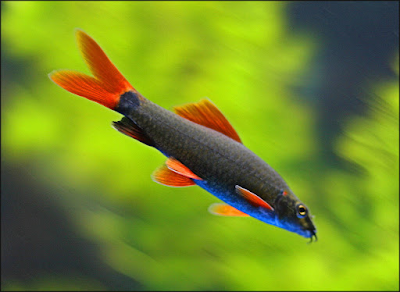
Note: Assume that if the fish is smaller than 4 inches in length, they are not sexually mature yet.
Rainbow Shark Eggs: Rainbow Sharks reproduce through the egg-laying process. The female Rainbow Shark will lay eggs. After that, the male will then fertilize them by spraying the eggs with their sperm.
From this moment, the eggs will hatch within a week. When this tropical shark starts to hatch from eggs, they are not much bigger than a mere specks. From that moment, they began to grow rapidly.
Unfortunately, it is extremely challenging to breed Rainbow Sharks in an aquarium, and we have yet to hear any success stories.
Again, this is more than similar because of their territorial and aggressive nature in confined settings.
The majority of Rainbow Sharks that you find for purchase will be bred in commercial fish farms based in Southeast Asia.
What’s Next? Do You Feel That The Rainbow Shark Is Right For Your Fish Tank? (Summary)
Now that you have a much better understanding of rainbow sharks and the way to care for them, it’s on you to make a decision if you would like to provide it a trial.
As we covered above, they require specific conditions so as to thrive and coexist with other fish. They do not belong to the highest-maintenance fish out there, but again, these fish are not the run-of-the-mill goldfish either…!
Despite the additional work, we believe that these sharks are a number of the foremost rewarding fish you’ll keep. They appear great, are a lot of fun to observe, and are a good way to take your fishkeeping journey to the next level.
This tropical fish will make an excellent addition to your community, provided they are not kept with similar-looking fish.
While they’re known for being territorial, providing you give them an appropriate aquarium environment and match them with the acceptable tank mate(s), you should not have too many issues with them.
They are an active swimmer and gorgeous fish, therefore, they will give you enjoyment when watching them in an aquarium. They’re good eaters and can eat a spread of food forms, including flakes, pellets, and frozen meat.
If you intend to keep Rainbow Sharks, you must also make sure that you have already got some fish-keeping experience, as these fish are generally not for beginners.
Do you keep Rainbow Sharks? Let us know in the comments section below…
